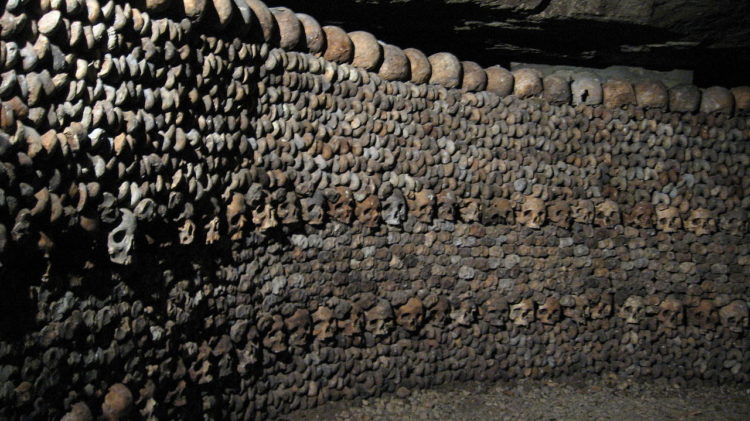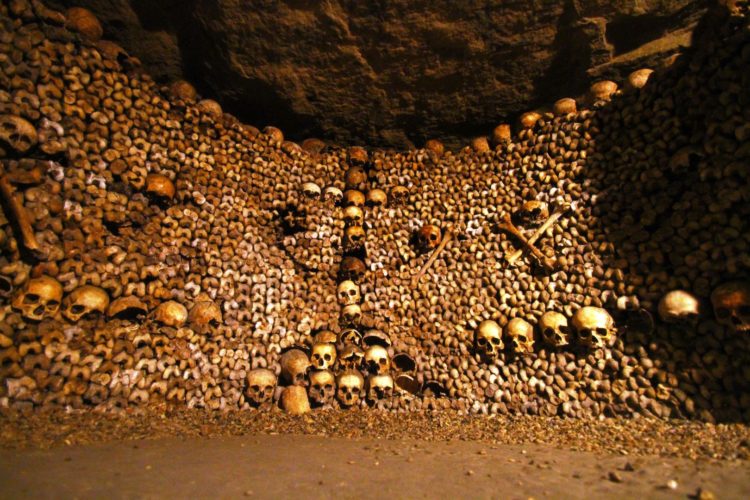Catacombes de Paris is most macabre underground tunnels lined with skulls and bones.
In 2004, Parisian police were transferred to complete a training exercise in an uncharted part of the Catacombs of Paris beneath the Palais de Chaillot. Entering the catacombs through a drain, officers first came across a sign that read “Building site, no access,” and moved ahead a camera that actively recorded images of those who passed.
The police descended deeper into the tunnels and discovered a 500-square-meter cavern with a fully equipped giant cinema screen, projection equipment, chairs, and a handful of films, from film noir classics to recent thrillers. Someone had turned this abandoned underground cavern into a secret amphitheater.
Moreover, in the next “room” police discovered a fully-stocked bar and restaurant, with tables and chairs. This discovery left police perplexed, not to mention the professional installation of electricity and three phone lines. Thus, police returned with specialists from the French Board of Electricity to try and find out where the power was coming from.
The cables had been cut and a note lying on the floor read, “Do not try and find us.” The Catacombs of Paris are underground ossuaries in Paris, France, which hold the remains of more than six million people in a small part of the ancient Mines of Paris tunnel network.
In Catacombes de Paris the bones of around six million people lie beneath the streets of Paris in 280 km of dank passageways. The officials were pushed to move bones into the catacombs because the cemeteries above ran out of room for the dead.
The Catacombes de Paris limestone quarries tunnels have existed on the outskirts of Paris since Roman times built Paris. Eventually, abetted the city expand to the point where the quarries were directly underneath the busy metropolis. About 200 miles of labyrinthine tunnels are believed to exist. Despite the vast length of the tunneled, underground world, only a small section of it is open to the public.
This minute portion, identified as Denfert-Rochereau Ossuary, or more commonly, “The Catacombs,” has become one of the top tourist attractions in Paris on a small scale from the early 19th century, and has been open to the public on a regular basis since 1874 with surface access from a building at Place Denfert-Rochereau in the extreme southern part of the city of Paris.
This is easily called Paris’ most macabre sight in its underground tunnels lined with skulls and bones. In 1785, it was decided to rectify the hygiene problems of Paris’ overflowing cemeteries by exhuming the bones and storing them in disused quarry tunnels and the Catacombes de Paris were created in 1810.
The popular place houses the skeletal remains of some six to seven million former Parisians, however not all areas of the Catacombs are open to the public. Back in the late 18th century, cemeteries were becoming overpopulated, such as Les Innocents were so stuffed with the dead that it led to improper burials, open graves, and unearthed corpses.
Neighbors began getting sick with infectious diseases due to the unhealthy conditions of the cemetery. Les Innocents was not the only cemetery that was condemned. Several other graveyards were becoming overpopulated, causing glitches for the inhabitants of Paris.
As tons of empty quarries, police, and priests similar discreetly moved the bones over the period of a few decades to the renovated section of the tunnel. The Catacombs became a favorite attraction for royal families and in 1867; the area was opened to the public.
The Catacombs are among the 14 City of Paris Museums managed by Paris Musées since January 1, 2013. The catacombs are called “The World’s Largest Grave” due to the number of remains buried. Although the ossuary comprises only a small section of the underground “carrières de Paris” Parisians presently often refer to the entire tunnel network as “the catacombs”.
Due to their old age, the quarries not part of the official Catacombs have been deemed unsafe by Parisian officials. Yet, the size and length of the tunnels make it problematic to keep secret societies, thieves, artists, and the inquisitive public from entering the unsafe network. In the 1980s, a movement was steadfast to the exploration of the tunnels.
After the discovery of the secret cinema, Patrick Alk, a photographer close to the group responsible said the discovery “was a shame, but not the end of the world.” There are dozens of other meeting places just like the one the police discovered in the mysterious labyrinth. He concluded, saying, “You guys have no idea what’s down there.”
Due to vandalism and the theft of numerous skulls, the Catacombes de Paris were closed from Oct 2009 till December of the same year. With the reopening of the site comes additional security and bag check upon exiting. During WWII these tunnels were used as a headquarters by the resistance. However, nowadays, thrill-seeking cataphiles are often caught (and fined) roaming the tunnels at night. Catacombes de Paris is must visit place whenever you go to this part of the world.
Also Read: Quarzazate – The Door of the Desert














